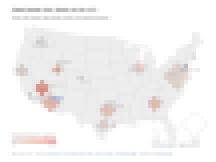Over the last three years, generative artificial intelligence made its way into many classrooms. Now, a White House initiative could plant the pervasive technology right outside of schools as well.
Late last month, the Trump administration rolled out its “Winning the AI Race: America’s AI Action Plan,” detailing efforts to accelerate innovation, build AI infrastructure and boost international diplomacy and security across 90 policy changes.
One key focus is “promoting rapid expansion” of data centers, which are large, standalone buildings housing tech systems that support AI’s workload.
Data centers — typically the size of a Walmart — are already rapidly cropping up across the nation. Virginia, deemed the “data center capital of the U.S.,” reports housing 35 percent of all known “hyperscale” data centers worldwide.
The structures could begin to creep into more communities, including near schools, if local zoning allows.

But with those come concerns. The centers, as well as AI as a whole, use large amounts of energy and put out large amounts of heat. Most of the centers are made with concrete, which emit high levels of carbon. The centers also require large amounts of potable water, which Joseph Carvalko, chairman of Yale University’s Technology and Ethics working group, says could lead to draining local reservoirs. Averaging 100,000 square feet, they create an imposing physical presence, thanks to their size and accompanying power lines.
For these reasons, some communities are trying to limit the encroachment of data centers. Louisa County, Virginia, recently made headlines for pushing back against a proposed Amazon Web Services data center spanning 7.2 million square feet. Residents feared it would affect drinking water, decimate valuable rural land and contribute to sound pollution.
“We’re letting or even entertaining the idea of a billion dollar corporation coming around and messing with our drinking water. I think it’s pretty humiliating,” Louisa resident Brittany Carroll said in an interview with The Virginia Mercury.
The construction of data centers next to schools doesn’t necessarily create problems unique to schools alone, according to Andrew Chien, a professor of computer science at the University of Chicago.
But similar to Louisa County, it could bring concerns to the community as a whole.
“There is increased power use and water use; generally that’s a regional issue,” Chien says.
Both Chien and Carvalko expect the centers to go into small towns that may not have the wherewithal to combat the possible downsides or have the proper zoning laws in place to mitigate them.
“Smaller communities are particularly vulnerable in my own opinion for good reason,” Carvalko says. “Having worked in corporations my entire life, corporations will take advantage of a small community, because they realize it'll be easier to get through them versus larger communities. They'll give them tax breaks and incentivize them, but they can't fix the environment.”
While corporations tout the centers as job builders, in reality the job creation is minimal — and the employment opportunities are very short term. According to a report by Stanford University’s Bill Lane Center for the American West, the jobs claim can be dubious, pointing out situations like in Phoenix and a small county in Oregon, where some officials faced recalls after giving millions in tax breaks to large tech companies.
“The problem with data centers is they have a non-local benefit,” Chien says. “Normally, with a factory, you get jobs and investments in the community. But this serves AI and computation with people far away. And I think some communities will decide they had enough of it.”
That won’t stop AI companies continuing though, especially now that they have official support from the White House.
“The question is, ‘How much computing do you think we can use?’ and the answer is infinite,” Chien says. “So, it’s about where it's going to be, and how to do it safely and cleanly.”
There are some efforts underway to make the centers more environmentally sustainable. A group of Harvard engineering students spent their spring semester creating four tools to help developers find new, ecologically friendlier locations or transition existing locations to more sustainable technologies. Carvalko added there is a push toward smaller data centers, called edge data centers, more similar to the size of a car versus a super store.
“That would probably be more accepted and more sustainable,” he says. “Eventually I think they will find their own market and be part of this system of data centers and perhaps a good part of it.”
Despite concerns, a possible upside for students who attend school near a data center is exposure to a new career option.
“It might be inspiring; if they made it attractive, it could inspire kids to work on AI and tech,” Chien says.


